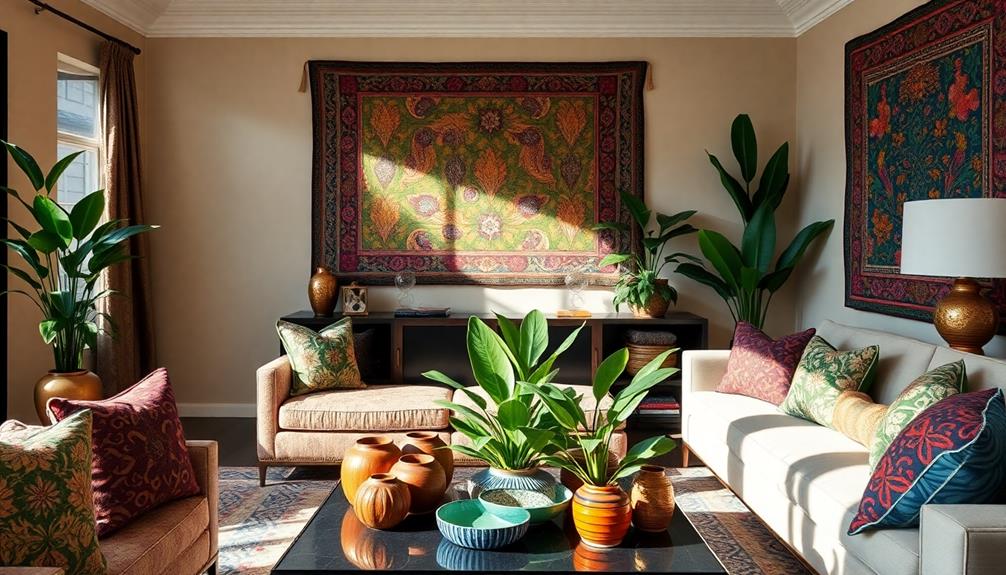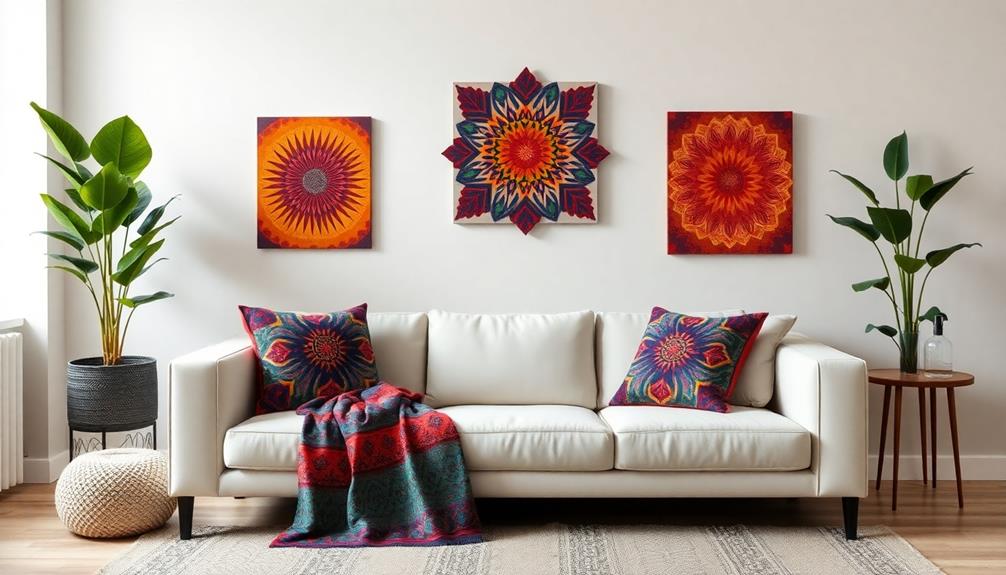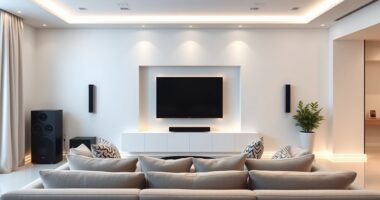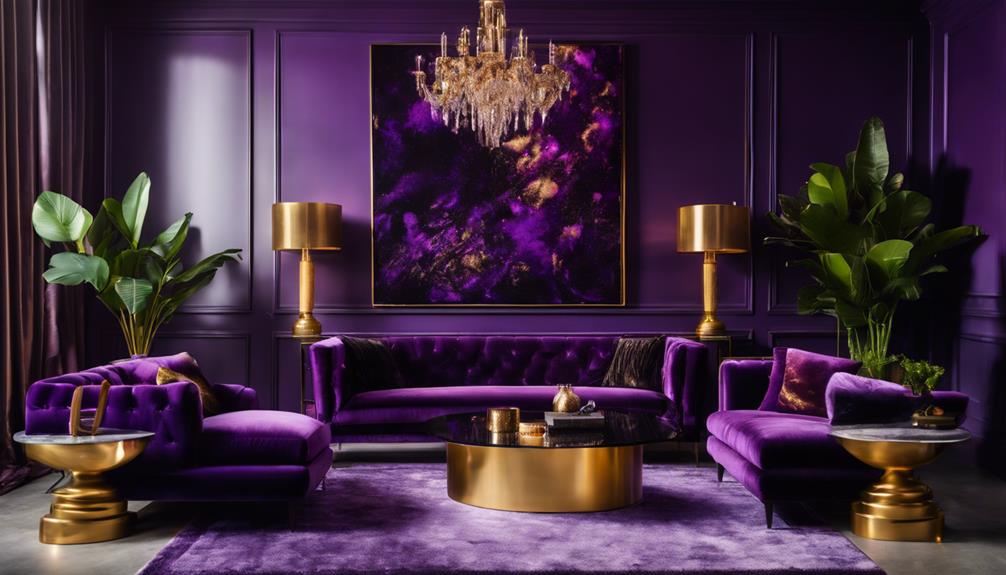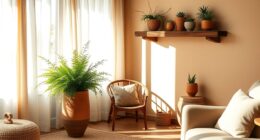Batik can elevate your interiors by adding vibrant colors and intricate patterns that reflect rich cultural heritage. This traditional Indonesian textile art uses a wax-resist dyeing technique, creating unique designs that tell stories. You can incorporate batik through accent pieces like throw pillows or wall hangings, instantly adding warmth and character to any space. By balancing bold batik with neutral decor, you'll create a cohesive look that highlights craftsmanship. Whether you choose the hand-drawn or stamped variety, batik offers a versatile touch that blends beautifully with modern aesthetics. Explore how to make batik a focal point in your home.
Key Takeaways
- Batik features intricate designs and vibrant colors that enhance various interior styles, from bohemian to minimalist.
- Incorporating large-scale batik textiles creates striking focal points in your decor.
- Smaller batik accent pieces, like cushions and throws, add texture and cultural richness to a space.
- Balancing batik's bold patterns with neutral elements ensures a cohesive and harmonious design.
- The growing interest in sustainable textiles boosts batik's popularity, making it a trendy choice for modern interiors.
Understanding Batik
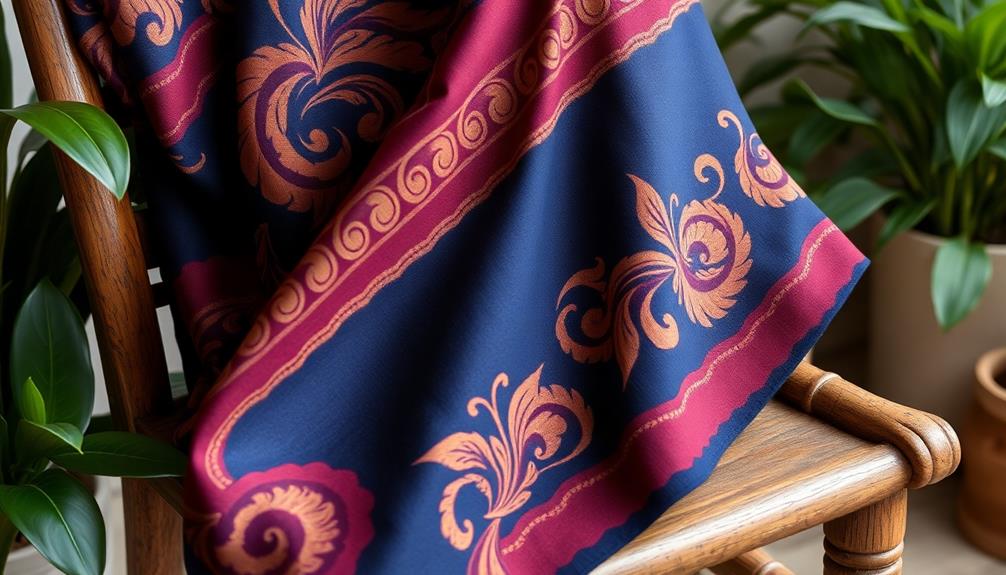
Batik is often celebrated as a vibrant and intricate textile art form that has its roots in Indonesia. This traditional craft employs a unique wax-resist dyeing technique, allowing artisans to create stunning patterns on fabric.
You might be fascinated to learn that the name "batik" comes from the Javanese word "bathikan," which means mark-making. By applying hot wax to fabric before dyeing, artisans can produce detailed designs that reflect Indonesia's rich cultural heritage. Additionally, batik shares similarities with other forms of traditional art, such as the unique artistic expressions found in Indonesian decor masks, showcasing the country's diverse cultural artistry.
Among the various types of batik, Batik Tulis stands out. This hand-drawn method showcases the skill and creativity of the artist, making each piece one-of-a-kind. You can appreciate the intricate patterns and vibrant colors that make batik an exceptional Indonesian textile.
The cultural significance of batik extends beyond mere aesthetics; it's a symbol of identity and tradition, recognized by UNESCO as an important part of Indonesia's heritage.
When you incorporate batik into your interiors, you invite a piece of this rich cultural legacy into your space. The stunning patterns and colors of batik can serve as a conversation starter, enhancing the ambiance and storytelling within your home. Not only does it bring beauty, but the symbolism of batik in decor adds a deeper layer of meaning, as each design often carries its own cultural significance or story. Whether you choose a bold, intricate pattern or something more subtle, incorporating batik into your interiors can reflect a sense of heritage and artistry. It’s a unique way to personalize your living space while honoring traditional craftsmanship.
History and Origins

Batik is an ancient wax-resist technique that's woven into the cultural heritage of many regions, especially in Indonesia.
As you explore its origins, you'll notice the unique regional variations that have emerged, each reflecting the local traditions and materials.
This rich history not only showcases the artistry involved but also highlights batik's influence across different cultures.
Additionally, like traditional artistry of Indonesian decor masks, batik embodies a vibrant expression of cultural identity, making it a cherished element in home decor.
Ancient Wax-Resist Technique
Dating back over 2,000 years, the ancient wax-resist dyeing technique has roots believed to lie in regions like Africa, India, Sri Lanka, or China, before spreading to Java through trade.
This process flourished in Java, Indonesia, where you'll find the creation of stunning batik fabric, made from natural materials like cotton, beeswax, and dye plants. The method involves applying hot wax to fabric, allowing for intricate patterns and designs to emerge once dyed.
Batik fabric often features vibrant colors and intricate patterns that can enhance your living spaces, making it a versatile choice in Indonesian decorative pillows. As an interior designer, you can appreciate how batik's unique wax-resist designs transform spaces.
The term "batik" comes from the Javanese word "bathikan," meaning mark-making, reflecting the artistry involved. There are two prominent styles: Batik Tulis, which is hand-drawn and labor-intensive, and Batik Cap, a quicker stamped technique.
Both forms are recognized by UNESCO as Masterpieces of the Intangible Heritage of Humanity, emphasizing their cultural significance.
Cultural Heritage Influence
With roots deeply embedded in the cultural tapestry of Indonesia, the art of batik embodies a rich history that reflects both local traditions and broader influences. This ancient wax-resist dyeing technique, which originated over 2,000 years ago, showcases intricate designs that carry profound cultural significance. The term "batik" comes from the Javanese word "bathikan," highlighting the mark-making process essential to creating these textiles.
In addition, batik shares similarities with other Indonesian handicrafts, such as the decorative masks that also represent the nation's vibrant culture and artistry, making them a great addition to home decor.
In Indonesian culture, batik is more than just a decorative art; it serves as a visual language. Specific symbolic motifs convey social status, with certain patterns reserved for royalty or significant life events like births and marriages. This connection to heritage makes traditional batik a crucial aspect of Indonesian identity, interwoven with the nation's customs and beliefs.
The UNESCO recognition of Batik Tulis and Batik Cap as Masterpieces of Intangible Heritage further underscores its importance. By incorporating batik into your interiors, you're not just adding aesthetic appeal; you're embracing a vibrant cultural heritage that tells stories of the past and enriches the present.
Regional Variations in Indonesia
Indonesia's diverse regions contribute to a rich tapestry of batik styles, each reflecting local culture and influences. Originating in Java, batik emerged as a unique textile art form, utilizing natural materials like cotton and dye plants.
As you explore regional variations, you'll notice that inland areas often showcase more intricate batik patterns, while coastal regions draw inspiration from trade, blending foreign design elements into their textiles. These patterns can be beautifully incorporated into event decor, such as Indonesian wedding decor ideas, adding a layer of cultural significance.
Historical artifacts reveal that batik practices date back over 2,000 years, with roots found in ancient Chinese and Egyptian textiles. This deep history highlights batik as not just a craft but a significant art form.
The techniques and styles have also traveled beyond Indonesia's borders; for instance, batik in Malaysia took cues from Javanese methods, focusing on floral motifs that reflect local cultural aesthetics.
As you incorporate these regional variations into your interiors, you'll appreciate how each piece tells a story, connecting you to Indonesia's rich heritage. By selecting batik textiles that resonate with specific cultural aesthetics, you elevate your space, making it not just stylish but also meaningful.
Characteristics of Batik
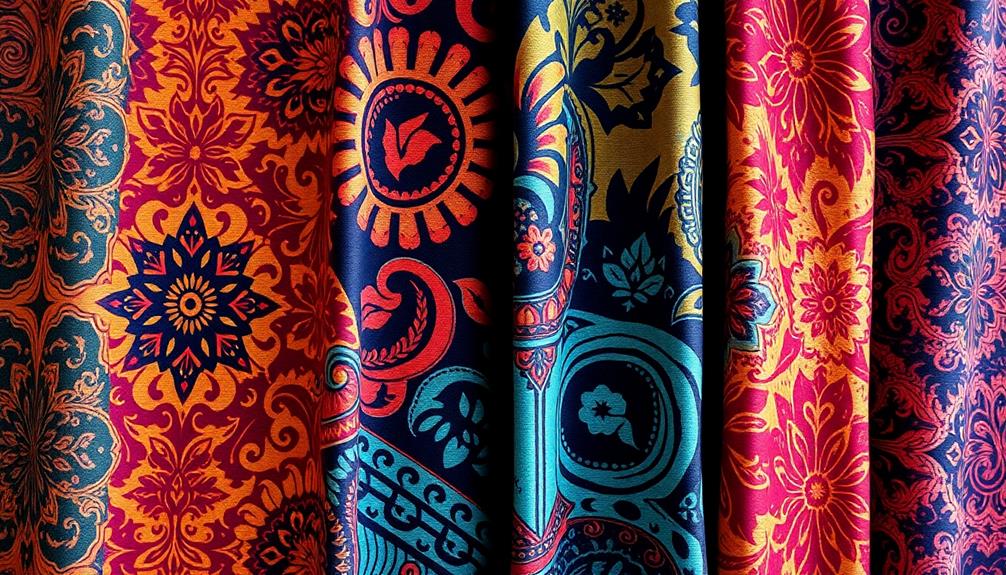
Batik stands out for its intricate designs and rich cultural significance, making it a unique choice for interior decor. The art of batik involves a labor-intensive wax-resist dyeing process where hot wax is applied to fabric, preserving the underlying patterns during dyeing. This method results in stunning batik designs that capture attention and spark conversation.
Incorporating batik into your home can be complemented by traditional Indonesian style home decor, which emphasizes harmony with nature and intricate craftsmanship. Each piece of batik often features geometric patterns and traditional motifs, which convey specific meanings tied to social status, nature, and virtues. This connection to cultural significance adds depth to your decor, transforming patterned textiles into storytelling elements. You'll find that the color palette in batik varies widely, allowing you to choose pieces that complement or enhance your existing interior style.
Batik is typically crafted from natural fabrics like cotton, silk, and rayon, ensuring quality and durability. Recognized globally for its craftsmanship, authentic batik has even earned UNESCO's designation as a Masterpiece of Intangible Heritage.
Types of Batik
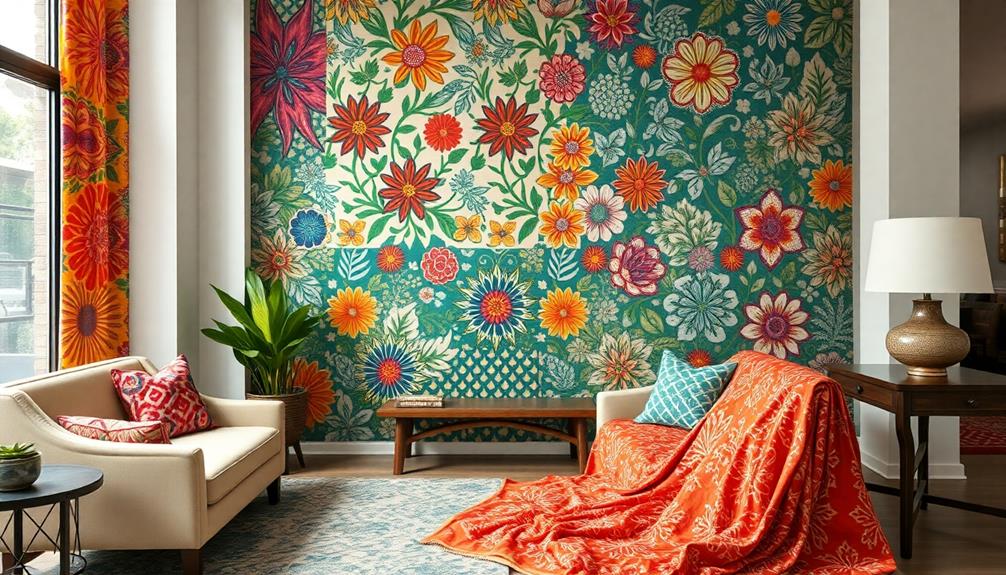
When exploring the types of batik, you'll find that Batik Tulis stands out for its intricate, hand-drawn designs, showcasing the artist's skill. This traditional technique is often used in creating unique pieces that reflect cultural significance and heritage, much like the architectural styles of traditional Indonesian housing.
On the other hand, Batik Cap offers a quicker method through stamping, allowing for consistent patterns.
Batik Tulis Characteristics
In the world of textiles, Batik Tulis stands out as the most traditional and exquisite form of batik. This beautiful craft showcases the talent of skilled batik artists who create intricate hand-drawn designs using a canting tool. Each piece is unique, reflecting the artisan's personal style and cultural heritage.
The artistry of Batik Tulis can also beautifully complement Balinese interior design, where natural materials like wood and stone enhance the richness of these textiles.
Here are four key characteristics of Batik Tulis:
- Labor-Intensive Craft: The production of Batik Tulis takes several days to complete, making it the most expensive type of batik.
- Unique Designs: Every design is distinct, often incorporating geometric shapes and patterns that tell a story.
- Natural Dyes: Batik artists use natural dyes, resulting in vibrant colors that connect deeply with local flora and traditional dyeing techniques.
- Cultural Significance: Batik Tulis is often used to create ceremonial garments and heirlooms, symbolizing identity within Indonesian society.
Batik Cap Process
Utilizing a stamped technique, Batik Cap offers a fascinating contrast to the hand-drawn artistry of Batik Tulis. This method enhances efficiency in creating stunning designs, allowing artisans to produce intricate pieces with uniform patterns. The process begins with designing a copper stamp, which is used to apply melted wax to fabric. This stamped wax pattern then resists dye during the dyeing technique, resulting in striking motifs once the wax is removed.
Here's a quick comparison of Batik Cap and Batik Tulis:
| Feature | Batik Cap |
|---|---|
| Technique | Stamped using metal stamps (cap) |
| Production Speed | Faster than hand-drawn Batik Tulis |
| Pattern Style | More uniform, ideal for mass production |
The Batik Cap method is not just about efficiency; it holds cultural significance, recognized by UNESCO as a Masterpiece of Intangible Heritage. By choosing Batik Cap for your interiors, you're not only adding visual interest but also celebrating a rich tradition. Embrace the beauty of this dyeing technique, and let it transform your space.
Modern Batik Innovations
Modern batik innovations showcase a vibrant evolution of traditional techniques, allowing artists to blend cultural heritage with contemporary design.
These modern interpretations not only enhance the artistic landscape but also provide you with visually appealing options for your interior design projects, such as the luxury tropical designs offered by Mahallati Interiors.
Here's a quick look at some types of modern batik:
- Batik Tulis: The most traditional and labor-intensive, this technique uses a canting tool for intricate, unique designs.
- Batik Cap: Created by stamping with copper, it offers quicker production while maintaining cultural significance.
- Batik Lukis: A modern approach where artists paint directly on fabric, giving them creative freedom to express contemporary themes.
- Batik Pesisir: Reflecting coastal influences, this style features vibrant colors and patterns, appealing to a broader market.
Incorporating these modern batik innovations into your home can transform a space with their unique designs and color schemes.
Whether you choose the handcrafted elegance of Batik Tulis or the bold vibrancy of Batik Pesisir, each piece adds a story and richness to your interiors.
Cultural Significance

Batik motifs frequently carry deep cultural meanings, reflecting social status, virtues, and historical narratives within Indonesian society. Each pattern tells a story, with specific designs like the parang reserved for royalty, showcasing the intricate relationship between art and identity.
Recognized by UNESCO as part of Indonesia's intangible cultural heritage, batik isn't just fabric; it's a powerful storytelling medium that encapsulates collective beliefs and values. The rich textures and colors of batik can complement the modern tropical aesthetics found in Bali, where natural materials and open designs promote a harmonious living environment and a connection to nature (integrating Balinese style).
The handmade nature of batik enhances its artistic value, transforming it into a treasured family heirloom passed down through generations. This significance connects you to a rich cultural heritage, allowing you to appreciate the depth behind each design.
As you incorporate batik into your interiors, consider how these traditional motifs can resonate with your space, bringing historical narratives to life.
Modern interpretations of batik bridge the gap between past and present, integrating these timeless patterns into contemporary aesthetics. By choosing batik for your home, you're not only elevating your interior design but also honoring and preserving an essential cultural legacy.
Embrace the beauty and meaning of batik, and let it inspire your surroundings with its vibrant stories.
Modern Applications

Incorporating batik into your interiors opens up a world of possibilities for modern design. By using this vibrant batik fabric, you can enhance your space with a unique cultural touch that reflects intricate storytelling and rich heritage.
Here are four ways to modernize your home decor with batik:
- Accent Pieces: Use batik fabrics for throw pillows, curtains, or table runners to add pops of color and texture.
- Statement Furniture: Consider upholstered chairs or benches in bold batik patterns, making them focal points in your living space.
- Wall Art: Hang large-scale batik tapestries or framed pieces to create a striking visual impact while celebrating artistic textiles.
- Custom Designs: For special events, incorporate batik in custom decor items, blending tradition with modern design aesthetics.
Incorporating Batik in Decor
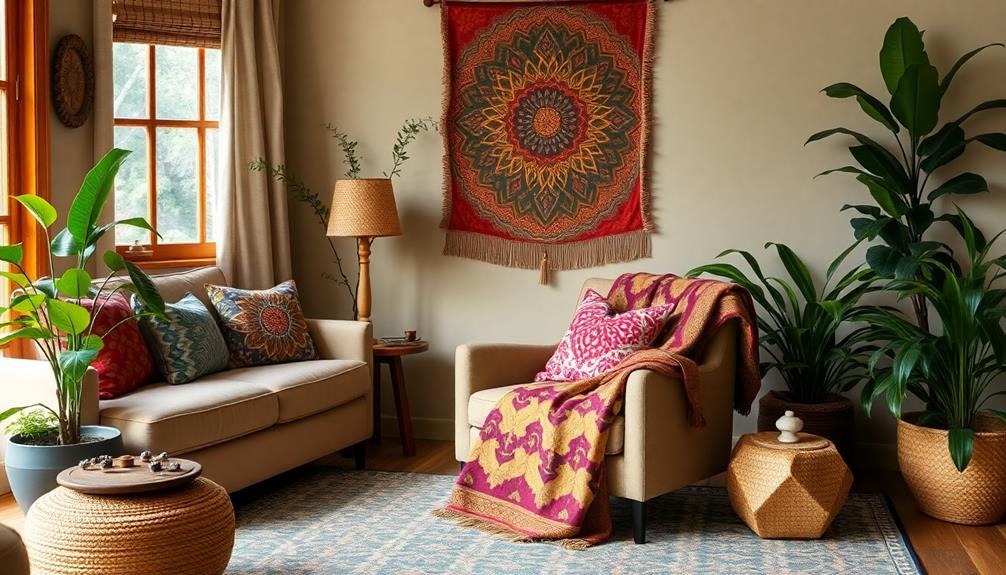
Transforming your home decor with batik opens the door to a vibrant tapestry of colors and patterns that can evoke a sense of cultural richness. You can incorporate batik through accent pieces like throw pillows, curtains, and wall art, enhancing visual interest with its intricate designs.
Large-scale batik textiles or tapestries can serve as striking focal points in any room, creating a backdrop that celebrates cultural heritage.
Whether you choose Batik Tulis (hand-drawn) or Batik Cap (stamped), the unique characteristics of each allow for diverse applications in your decor. This versatility makes batik suitable for various interior styles, from bohemian and eclectic to modern and minimalist, adding a touch of exotic elegance.
To achieve a cohesive look, balance the boldness of batik's vibrant colors with neutral elements. This approach prevents the design from becoming overwhelming, ensuring that batik enhances rather than dominates your space.
Design Considerations
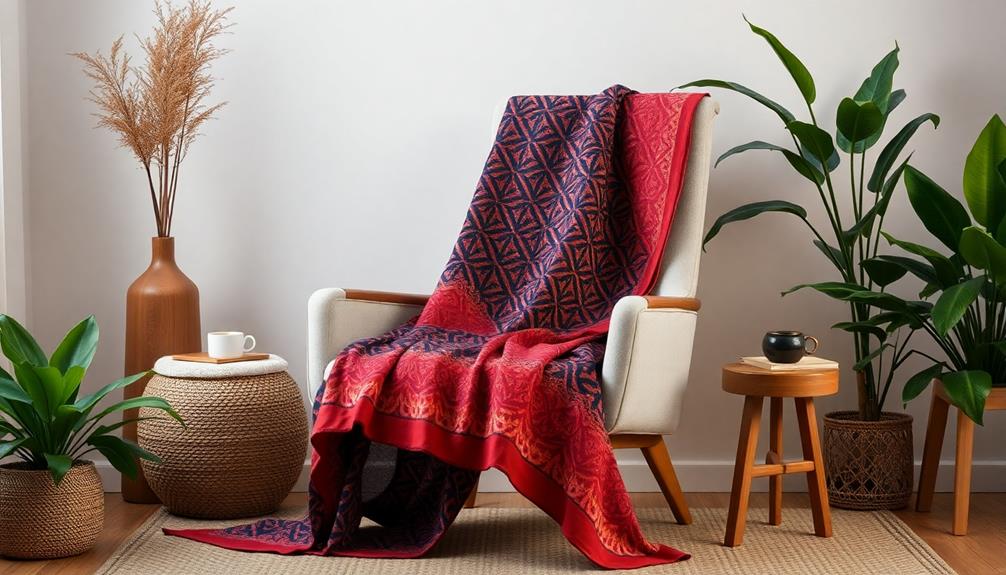
When considering batik for your interior design, balancing the bold patterns with minimalistic elements is essential for achieving elegance without overwhelming the space.
Authentic batik pieces can act as statement items, adding depth and character to your interiors. Here are some design considerations to keep in mind:
- Choose Statement Pieces: Use wall-mounted batik panels or upholstered furniture to create focal points in your room.
- Mind the Color Palette: Guarantee that the vibrant colors of batik complement or contrast effectively with your existing decor for a cohesive look.
- Incorporate Subtly: Use batik as accent pieces, like cushions or throws, to subtly enrich your space while maintaining overall design harmony.
- Avoid Clutter: Don't overuse batik patterns; strategically select and place elements to preserve visual flow and interest throughout the interior.
Future Trends in Batik
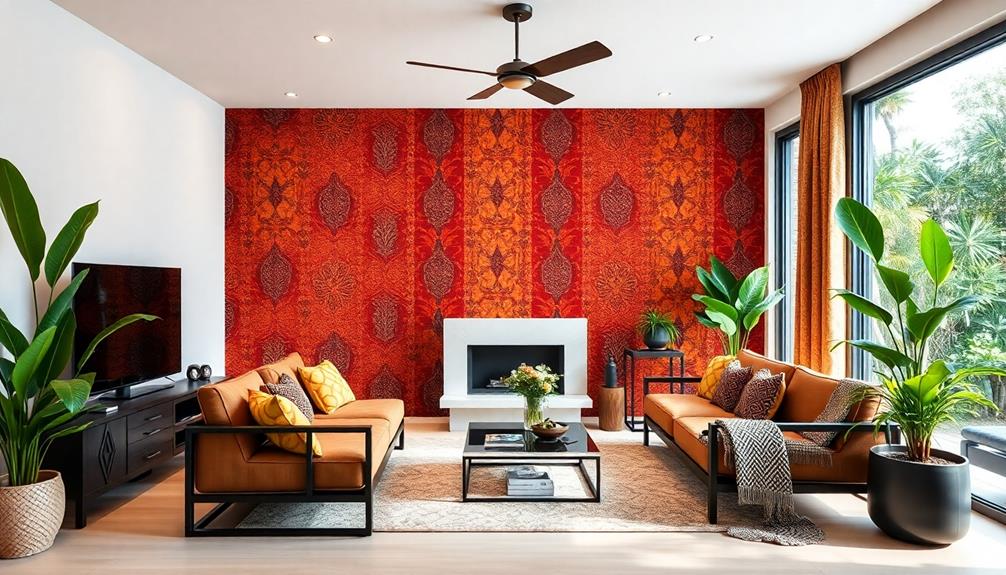
As you explore the evolving landscape of interior design, batik is poised to make a significant impact in the coming years. The resurgence of interest in sustainable and handmade textiles means that authentic batik is gaining traction. Consumers increasingly prioritize eco-friendly materials, making batik a perfect fit for modern interiors.
You'll notice that contemporary designers are creatively integrating traditional batik motifs into their work, showcasing its versatility. This fusion of heritage and modern aesthetics isn't just a trend; it's a movement.
Batik workshops and online communities are blossoming globally, allowing new generations of artisans to learn traditional techniques while experimenting with innovative designs and vibrant color combinations.
Moreover, collaborations between traditional artisans and modern designers are resulting in unique collections that appeal to a broader audience. As batik receives recognition as a UNESCO Masterpiece of the Intangible Heritage of Humanity, its status in the design world continues to rise.
This means you can expect to see batik not just in fashion but also in high-end interiors, as its rich heritage and sustainable qualities become essential elements in your design choices.
Frequently Asked Questions
What Are the Elements of Batik Design?
Batik design elements include intricate patterns, symbolic motifs, and various techniques like hand-drawing or stamping. These aspects reflect cultural significance, craftsmanship, and artistry, making each piece unique and often imbued with deeper meanings.
What Are the 5 Major Types of Batik Design?
Imagine vibrant fabrics swirling around you! You'll discover five major types of batik: Batik Tulis, Batik Cap, Batik Lukis, Batik Pesisir, and Batik Belanda. Each style tells a unique story through its intricate designs.
What Is Batik in Simple Terms?
Batik's a traditional art form where you create beautiful patterns on fabric using wax and dye. Originating from Indonesia, it combines intricate designs with cultural significance, making your textiles truly unique and meaningful.
What Is the Important of Batik?
Batik's important because it represents cultural heritage and artistry. By incorporating it into your space, you celebrate tradition and storytelling, while also adding unique patterns that enhance your home's character and vibrancy.
Conclusion
Incorporating batik into your interiors is like adding a splash of vibrant color to a monochrome canvas. Just as a single brushstroke can transform a painting, a piece of batik can elevate your space, weaving stories of culture and history into your decor. As you explore this art form, remember that every design tells a tale—your home becomes a gallery of experiences, inviting warmth and connection in every corner. Embrace batik, and let your walls speak.
